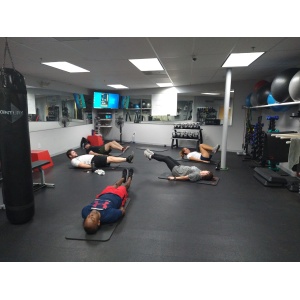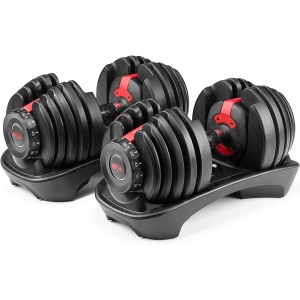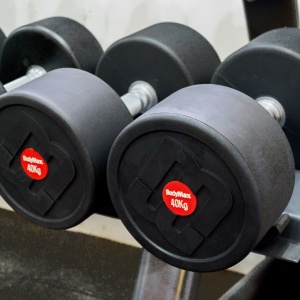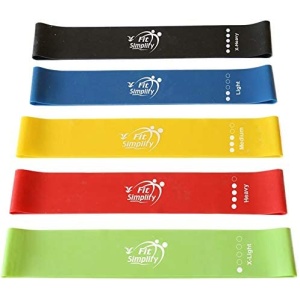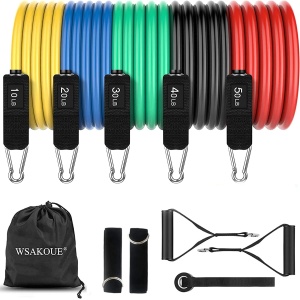Why Core Strength Is So Important?
Stop seeing abs work as an aesthetics-only endeavor. After this, you’ll consider your core your most important muscle group.
By Lauren Mazzo
Published on April 2, 2018
For as long as crop tops, bikinis, and, well, Britney Spears have been around, there’s been an all-consuming obsession with having a flat, six-pack stomach. Eavesdrop on a personal training consult and, more often than not, you’ll hear the client say, “I want abs.” Take a peek around the gym and you’ll probably see half the population cranking away at crunches, bicycles, the ab wheel, and other core moves that’ll make it hurt to laugh tomorrow.
Don’t get us wrong, it’s very important to have a strong core. But it’s about time we appreciate this ever-important muscle group for what it really does, and stop placing all its value on its resemblance to a pack of Coke cans.
These reasons will convince you to stop seeing your abs as a vanity project and start seeing the beyond-skin-deep benefits of working it out.
Your core is your entire support system.
Your core muscles play a huge role in your everyday activities, from getting out of bed, to walking down the street, and bending over to grab your purse-but, most importantly, they literally help you stay upright.
“That’s because your core muscles are the base of support for your entire body,” says Meredith McHale, P.T., D.P.T., regional clinical director at Professional Physical Therapy. They completely surround and support your spine and pelvis and connect your upper body and lower body, effectively transferring forces from one to the other.
Here’s an anatomy refresher: Your abs aren’t just one muscle. The deepest layer of abdominal muscles, and arguably the most important, is your transverse abdominis (sometimes called the “corset” or “Spanx” of the core), which stabilizes your spine and pelvis. Then you have two layers of oblique muscles, which control lateral flexion (think a side bend), rotation, and other spinal movements. Last but not least is the topmost muscle, the rectus abdominis, which runs vertically in the front of your abdomen and is the muscle you see as a six-pack. It flexes your torso forward, like in a crunch.
And when you’re talking about your whole core (versus just your abs), there are even more muscles involved: your pelvic floor muscles, the back muscles that stabilize your spine, and your diaphragm (the main muscle involved in breathing), says McHale.
“A strong core helps keep a more upright and erect posture whether you’re being active or just sitting at your desk,” says McHale. Think of it like the tree trunk of your body (albeit a lot more mobile): It has to hold its ground so that your branches (arms and legs) can do their ~thing~ any which way.
Core strength is crucial in every movement you do.
That stable base is super important when you start moving: “The ab muscles play a dominant role in movement in every plane of motion: sagittal (forward and backward), frontal (left and right), and transverse (rotational),” says Scott Mitsiell, C.S.C.S., strength coach at Soho Strength Lab in New York City.
Even when they don’t seem important, your core muscles are often the first-and most important guest-at the party.
“Typically, the core muscles fire or activate prior to us doing an activity,” says McHale. “Our nervous system anticipates the activity, and braces for support, really, when we go to do anything. If you don’t have that core stability and support acting as a brace or a girdle for your spine, you’re likely going to compensate with other muscles.”
And, ICYDK, compensating is a quick route to injury: “A weak core is the number-one risk for potential injuries, especially lower-back injuries,” says Kristina Jennings, a certified functional strength coach at Mike Boyle Strength and Conditioning in Boston. Research shows that core strength training (and training the deep trunk muscles specifically) can help alleviate lower-back pain.
“While back injuries are very common with a weak core, you can also injure other parts of your body as a result, like your shoulders, hips, and knees,” says McHale. Even if a weak core isn’t the sole reason for a person’s injury, it usually plays a part, which is why McHale says she almost always incorporates core work into her patients’ rehab.
You need to build enough core strength before you can build strength anywhere else…
For the most part, core strength is what keeps you from being able to complete or continue an exercise-even in moves where you’re not primarily working your abs, says Mitsiell. For example: During push-ups, are your hips sagging? Is your lower back arching and is your stomach is touching the ground first? In an overhead press, does your lower back arch and ribs pop forward to get the weight up? In a deadlift, does your back hurt or are you forced to either hunch forward or extend (arch) your back? In any of these cases, it’s likely you have weak abs, he says.
That’s why many exercise programs-like the American Council on Exercise’s Integrated Fitness Model-call for core stability and joint mobility work before introducing any other exercises. Building the proper base will not only help you avoid injury, but will help you perform better too. A study of runners published in the Journal of Strength and Conditioning Research found that runners who did six weeks of core strength training increased their speed in a 5000m run.
…but you need to use it correctly.
Having a strong core is just one part of the equation, though; you also need to know how to use it. “The majority of people who come in to see me have weak abs,” says Mitsiell. “But often, they’re not necessarily weak-their body just isn’t in the optimal position to use them, and may just not know how to ‘turn them on.’ This could be due to prolonged sitting, hunching, or even overextending/arching (which is what many people think good posture is).”
McHale agrees: “It’s more about increasing the person’s awareness of the muscle, then once they’re able to activate it, it’s much easier to activate that muscle in all exercises.” Use these tips to learn how to engage your core, and follow these instructions to make sure your core is working during all your workouts.
But before you add massive sets of Russian twists and leg lifts to your workout, listen up: “You’re at a higher risk for injury when repeating patterns such as flexion and rotation of the spine (ex: crunches or medicine ball twists) if done too frequently or incorrectly,” says Jennings. Instead, focus on stabilization or anti-rotation moves that keep your back from going into extension, like planks, she says. “Surprisingly, performing squats, farmer’s carries, and push-ups are also great ways to improve your core strength since it’s the main stabilizer and must be actively engaged throughout the exercise.”
And next time you catch yourself counting abs in the mirror, remember: It’s what’s deeper that really counts.
- Personal Training
12 Week Customized Personal Training Program
- Exercise Equipment
Bowflex Adjustable Dumbbells
- Exercise Equipment
Home Gym
- Exercise Equipment
Loop Exercise Bands
- Exercise Equipment
Resistance Bands


